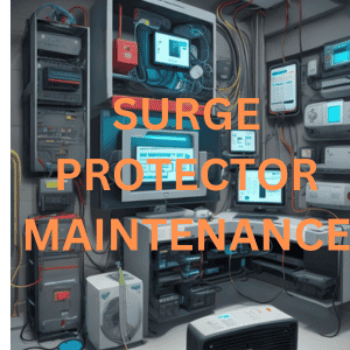Published By: Marc Edwards | Last updated on June 2, 2024 and reviewed by Editorial Team
Imagine this scenario: you’re working on an important project on your computer when suddenly, a lightning strike sends a jolt of electricity through your home’s wiring.
Suddenly, your computer shuts down, and you’re left in the dark.
It’s a frustrating, and all too common, experience.
Our reliance on electronics is ever-growing in the digital age, from computers and smartphones to home appliances. Power surges, caused by various factors like lightning, can wreak havoc on our electronic devices. They can lead to costly repairs, data loss, and the inconvenience of downtime. This is where surge protectors come to the rescue, but they, too, need protection in the form of regular maintenance.
In the following sections, we’ll explore the intricacies of surge protector maintenance. We will discuss common signs that your surge protector might need attention, walk you through a step-by-step maintenance guide, and answer frequently asked questions regarding these critical devices. We’ll also delve into the advantages of proper maintenance and why it’s an investment in the longevity and efficiency of your electronics.
So, let’s embark on this journey together, as we demystify the world of surge protector maintenance. By the end of this guide, you’ll have the knowledge and confidence to safeguard your electronic devices, ensuring they remain functional and protected, come what may.
The Importance of Surge Protectors
Power surges are not a rare occurrence. In fact, statistics reveal that lightning strikes account for a staggering 20% of power surges. These surges, whether from lightning, faulty wiring, or other sources, can lead to damaged equipment, data loss, and significant financial setbacks.
Surge protectors are our first line of defense against these potential disasters. They divert excess voltage away from your devices, ensuring that your electronics remain safe. They are our modern-day guardians, and like any guardians, they too require attention and care.
Surge Protector Maintenance: 9 Important Signs You Should Be Aware Of
When it comes to surge protectors, regular maintenance is the key to ensuring they function effectively. But how do you know when it’s time to roll up your sleeves and give your protector some TLC? Here are some telltale signs to watch out for:
| Signs Your Surge Protector Needs Maintenance | Indications |
| Visible Damage | Inspect your surge protector for any physical damage. Cracks, frayed cords, or scorch marks are clear indications that it needs attention. |
| Indicator Lights | Many surge protectors come with indicator lights to signal their status. If the light is off or blinking, it could mean your protector is compromised. |
| Flickering Lights | If you notice your lights flickering when high-power devices turn on, it could indicate that the protector isn’t coping with the load. |
| Devices Acting Up | Are your electronic devices behaving erratically, restarting, or shutting down unexpectedly? This might be due to voltage irregularities that your surge protector is failing to manage. |
| Age | Surge protectors have a lifespan, typically around 3-5 years. If you can’t remember when you last replaced yours, it might be time for an upgrade. |
| Tripped Circuit Breaker | If your surge protector causes your circuit breaker to trip, it could be overloaded or malfunctioning. |
| Audible Clicking | Some surge protectors emit a clicking sound when they work. If this sound becomes irregular or too frequent, it could indicate issues. |
| Frequent Thunderstorms | If your area is prone to thunderstorms or frequent power surges, your surge protector might degrade faster. |
| Failure to Protect | The ultimate sign – if your devices are damaged during a power surge, your surge protector unit has failed and it is time to get a replacement. |
The Takeaway: Ignoring these signs can have costly consequences. Regular inspection and maintenance can prevent the untimely demise of your surge protector and protect your valuable electronics.
In the next section, we’ll provide a step-by-step guide on how to maintain your surge protector and ensure it’s always ready to shield your devices from harm.
Step-by-Step Surge Protector Maintenance Guide
Now that you’re familiar with the signs of a surge protector in distress, let’s dive into the essential steps to maintain it and keep your electronics safe. Proper maintenance not only prolongs the life of your surge protector but also ensures it continues to provide reliable protection.
Cleaning Your Surge Protector
Dust and debris can accumulate over time, hampering your surge protector’s performance. Regular cleaning is a simple yet effective way to maintain it.
Steps for Cleaning:
- Unplug: Ensure the surge protector is unplugged from the wall outlet.
- Disassemble: If your surge protector allows, disassemble it by removing any connected devices and opening the casing.
- Blow Out Dust: Use compressed air or a can of compressed air duster to blow away dust and debris from the internal components and outlets.
- Clean Surfaces: Wipe down the external surfaces and outlets with a microfiber cloth. Ensure they are completely dry before reassembling.
- Reassemble: Put everything back together, ensuring all connections are secure.
Video Tutorial: For a visual guide on cleaning your surge protector, watch this:
Testing the Surge Protector
Testing your surge protector is crucial to confirm its reliability. Here’s how to do it:
Steps to Test:
- Unplug Devices: Disconnect all devices from the surge protector.
- Plug in a Tester: Use a voltage tester or a surge protector tester to check the functionality. Insert it into one of the surge protector’s outlets.
- Check Indicator Lights: Observe the indicator lights on the surge protector. They should indicate that it is functioning correctly.
- Test Reset Buttons: If your surge protector has reset buttons, press them to ensure they function correctly.
- Reconnect Devices: Plug your devices back into the surge protector once you’ve confirmed its functionality.
Testing Schedule: Use the following schedule as a reference for how often to test your surge protector:
| Frequency | Testing |
|---|---|
| Every Month | Quick functionality check |
| Every 6 Months | Comprehensive test using a voltage tester |
| After Power Surges | Immediate testing after any significant surge |
The Takeaway: Regular testing ensures that your surge protector is ready to protect your devices when needed. Following a schedule minimizes the risk of discovering a problem during a power surge.
Replacing Outlets and Surge Protector
Sometimes, it’s not just maintenance but replacement that’s required. Here’s when and how to replace outlets and surge protectors:
Steps to Replace Outlets and Surge Protector:
- Identify Damage: If you spot damaged outlets or surge protector components during cleaning or testing, it’s time for a replacement.
- Unplug: As always, unplug the surge protector from the wall outlet before starting.
- Purchase Replacement: Acquire a suitable replacement surge protector and outlets. Ensure they meet the necessary safety standards.
- Install New Components: Follow the manufacturer’s instructions to install the new surge protector and outlets.
- Proper Disposal: Safely dispose of the old surge protector and outlets. Many electronic retailers offer recycling programs.
By following these steps for maintenance and replacement, you can ensure your surge protector is in optimal condition to guard your electronic devices effectively. In the next section, we’ll address common questions about surge protector maintenance.
Advantages of Proper Surge Protector Maintenance
You might wonder if maintaining your surge protector is worth the effort. The answer is a resounding yes. Here, we explore the benefits of regular surge protector maintenance, which goes far beyond merely extending the life of this essential device.
1. Device Protection
- Prevents Damage: Properly maintained surge protectors offer robust protection against power surges, safeguarding your valuable electronics from damage.
- Data Preservation: By preventing power surges, you also ensure the safety of your data and avoid the stress of data recovery.
2. Cost Savings
- Prevents Replacement Costs: Regular maintenance reduces the need for frequent replacement, saving you money in the long run.
- Avoids Repair Expenses: Well-maintained surge protectors are less likely to fail and cause damage to your devices, which could incur significant repair costs.
3. Peace of Mind
- Reliability: Knowing that your surge protector is in optimal condition provides peace of mind, especially during thunderstorms or in areas prone to power surges.
- Reduced Downtime: Avoid the inconvenience of downtime caused by damaged electronics and the hassle of replacement.
4. Environmental Impact
- Sustainability: Extending the life of your surge protector reduces electronic waste, contributing to a more sustainable environment.
5. Insurance Claims
- Insurance Eligibility: Some insurance policies require proof of surge protection maintenance to cover damages caused by power surges.
6. Enhanced Performance
- Optimal Performance: A well-maintained surge protector is more effective in managing voltage fluctuations, ensuring your devices operate at their best.
Statistics: According to a study by the National Institute of Standards and Technology (NIST), regular surge protector maintenance can reduce the risk of electronic equipment damage by up to 50%.
By dedicating time to surge protector maintenance, you’re not just extending the life of the device itself; you’re also enhancing the longevity and efficiency of your electronics, saving money, and contributing to a more sustainable future. In the next section, we’ll wrap up our guide and encourage you to take action to safeguard your electronic investments.
Final Thoughts
 In the world of electronics, where we rely on an ever-increasing number of devices to work, communicate, and entertain, the importance of surge protectors cannot be overstated.
In the world of electronics, where we rely on an ever-increasing number of devices to work, communicate, and entertain, the importance of surge protectors cannot be overstated.
They act as the silent guardians of our precious gadgets, shielding them from the unpredictable power surges that could otherwise wreak havoc. But for these guardians to stand strong, they need your care and attention.
As we conclude our comprehensive guide to surge protector maintenance, here are some key takeaways to ensure your electronic investments remain protected:
Regular Maintenance Matters
- Regularly clean your surge protector to remove dust and debris.
- Test your surge protector periodically to confirm its functionality.
- Replace damaged outlets and surge protectors promptly.
Stay Vigilant for Warning Signs
- Be aware of signs such as visible damage, flickering lights, and device malfunctions.
- Act on these signs to prevent costly damage to your electronics.
Embrace Sustainability and Cost Savings
- Proper maintenance extends the life of your surge protector and reduces electronic waste.
- You’ll save money by avoiding costly repairs and device replacements.
Protect Your Data and Devices
- Well-maintained surge protectors prevent data loss and device damage during power surges.
Peace of Mind
- Regular maintenance provides the peace of mind that your electronic investments are secure.
Remember, this guide isn’t just about maintaining a device; it’s about safeguarding your digital life. And while we’ve covered a wealth of information on surge protectors, our journey doesn’t end here.
As a trusted resource in the field of technical writing and SEO, I encourage you to take action today. Inspect your surge protector, clean it, and test its functionality. If it’s time for a replacement, don’t hesitate. Your electronic devices are counting on you for protection, and with the knowledge you’ve gained from this guide, you’re well-equipped to provide it.
So, embrace surge protector maintenance as a routine task and ensure that your electronics remain safe and sound, come what may. Should you have any more questions or need further guidance, feel free to reach out. Together, we can make your electronic world safer and more reliable.
FAQs about Surge Protector Maintenance
As we delve deeper into the world of surge protector maintenance, it’s natural to have questions. In this section, we’ll address some of the most frequently asked questions to ensure you have a clear understanding of how to care for your surge protector.
Q1: How often should I clean my surge protector?
- It’s best to clean your surge protector every 3-6 months.
- However, if you live in a dusty environment or own pets, consider more frequent cleaning.
Q2: Do I need to unplug the surge protector when not in use?
- While it’s not mandatory, it’s a good practice to unplug it during extended periods of inactivity. This helps save energy and provides an added layer of protection.
Q3: Can I use a surge protector with a damaged cord?
- No, a damaged cord can compromise the surge protector’s effectiveness and safety. Replace it immediately.
Q4: What do I do if the surge protector trips the circuit breaker?
- It could be overloaded or malfunctioning. Unplug some devices to reduce the load, or consider upgrading to a surge protector with a higher joule rating.
Q5: Can I daisy-chain surge protectors for more outlets?
- It’s not recommended. Daisy-chaining can overload the initial surge protector and increase the risk of a power surge damaging your devices.
Q6: How do I know if my surge protector is providing sufficient protection?
- Check its joule rating and clamping voltage. A higher joule rating and lower clamping voltage indicate better protection.
Q7: Can I use a surge protector for all my electronic devices?
- Yes, surge protectors are versatile and can be used for computers, TVs, gaming consoles, and any other electronics susceptible to power surges.
Q8: Should I invest in a surge protector with a warranty?
- A surge protector with a warranty can provide peace of mind. Check the terms and coverage to make an informed decision.
Q9: How long does a surge protector last?
- Surge protectors typically have a lifespan of 3-5 years. Consider replacing them within this timeframe.
Q10: Can I use a surge protector with a UPS (Uninterruptible Power Supply)?
- Yes, combining a surge protector with a UPS is an excellent choice for added protection. The surge protector guards against surges, while the UPS provides power during outages.
Additional Resources
Before we bid adieu, here are some extra resources to further enhance your understanding of surge protectors and their maintenance:
1. Related Articles
2. Books
- “Surge Protection Test Handbook” by KeyTek
- “DC Power Supplies: Power Management and Surge Protection for Power Electronic Systems” by Nihal Kularatna
3. Video Tutorials
- Difference Between A Power Strip And A Surge Protector
- Surge Protector Buying Guide For Beginners
Your feedback is valuable to us. We’re committed to providing you with the best, most up-to-date information. If you have any feedback, or suggestions, or would like to see specific topics covered in the future, please don’t hesitate to reach out through the comments section or via email.
In the ever-connected world we live in, safeguarding our electronic devices isn’t just a matter of convenience; it’s a necessity. By taking the steps outlined in this guide, you’re actively protecting your valuable electronics from potential harm.









